Leadership and Management Report: Toyota Case Study Analysis
VerifiedAdded on 2021/01/02
|15
|5077
|471
Report
AI Summary
This report provides a comprehensive analysis of leadership and management practices at Toyota, a multinational automotive company. It begins by defining and comparing the roles and characteristics of leaders and managers, differentiating between their functions and responsibilities. The report then delves into the application of leadership and management theories, including situational leadership, systems leadership, and contingency theory, within the context of Toyota's operations. It assesses the strengths and weaknesses of these approaches, particularly in addressing challenges such as conflict management, staff turnover, and resource constraints. The report further explores key approaches to operations management and the crucial role leaders and managers play in achieving business objectives. It evaluates how leaders and managers can enhance operational efficiency and examines the impact of various factors within the business environment on operational management and decision-making. The analysis includes a critical evaluation of the application of operations management and its effects on the wider business environment, providing insights into Toyota's strategic approach to leadership and management.
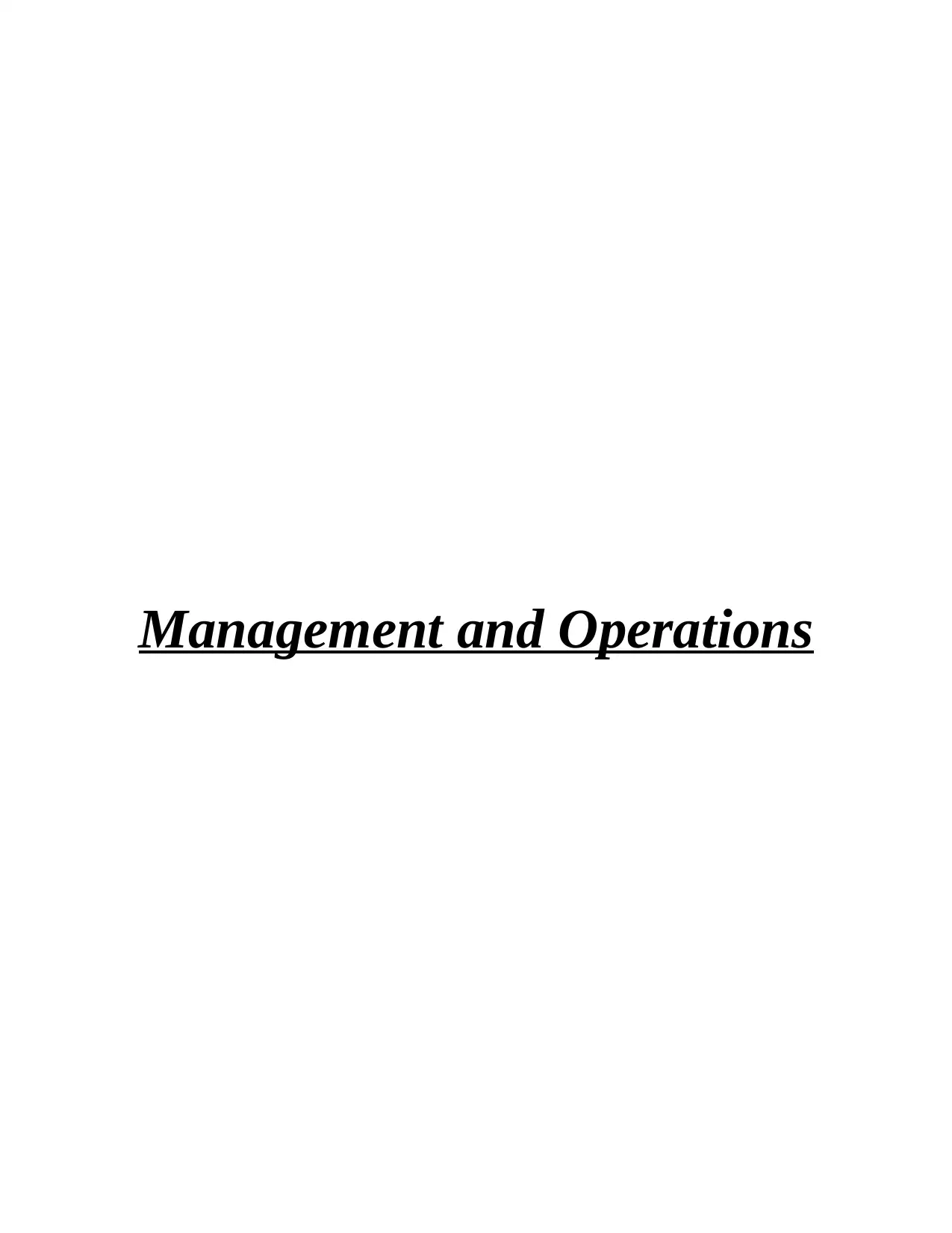
Management and Operations
Paraphrase This Document
Need a fresh take? Get an instant paraphrase of this document with our AI Paraphraser
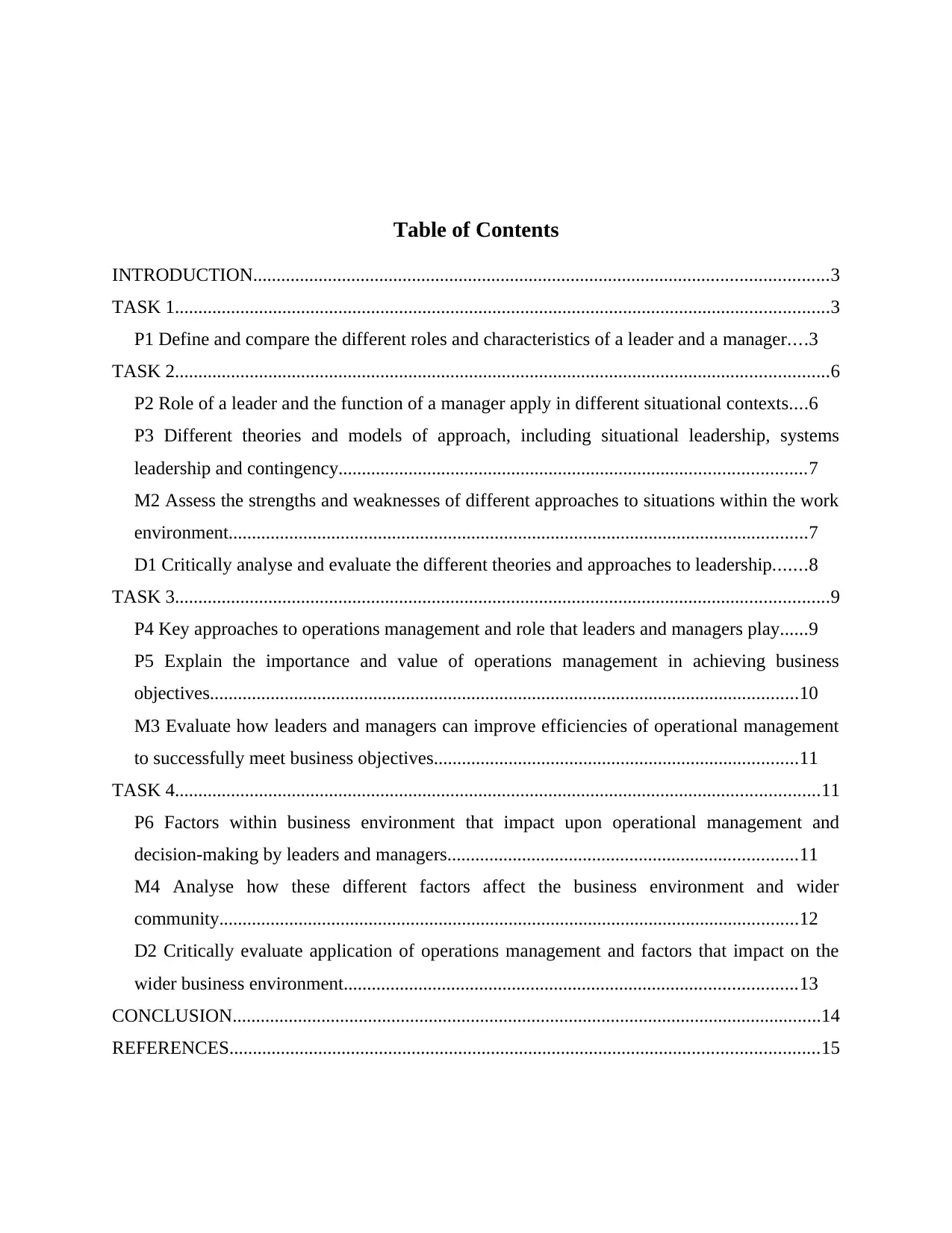
Table of Contents
INTRODUCTION...........................................................................................................................3
TASK 1............................................................................................................................................3
P1 Define and compare the different roles and characteristics of a leader and a manager....3
TASK 2............................................................................................................................................6
P2 Role of a leader and the function of a manager apply in different situational contexts....6
P3 Different theories and models of approach, including situational leadership, systems
leadership and contingency....................................................................................................7
M2 Assess the strengths and weaknesses of different approaches to situations within the work
environment............................................................................................................................7
D1 Critically analyse and evaluate the different theories and approaches to leadership.......8
TASK 3............................................................................................................................................9
P4 Key approaches to operations management and role that leaders and managers play......9
P5 Explain the importance and value of operations management in achieving business
objectives..............................................................................................................................10
M3 Evaluate how leaders and managers can improve efficiencies of operational management
to successfully meet business objectives..............................................................................11
TASK 4..........................................................................................................................................11
P6 Factors within business environment that impact upon operational management and
decision-making by leaders and managers...........................................................................11
M4 Analyse how these different factors affect the business environment and wider
community............................................................................................................................12
D2 Critically evaluate application of operations management and factors that impact on the
wider business environment.................................................................................................13
CONCLUSION..............................................................................................................................14
REFERENCES..............................................................................................................................15
INTRODUCTION...........................................................................................................................3
TASK 1............................................................................................................................................3
P1 Define and compare the different roles and characteristics of a leader and a manager....3
TASK 2............................................................................................................................................6
P2 Role of a leader and the function of a manager apply in different situational contexts....6
P3 Different theories and models of approach, including situational leadership, systems
leadership and contingency....................................................................................................7
M2 Assess the strengths and weaknesses of different approaches to situations within the work
environment............................................................................................................................7
D1 Critically analyse and evaluate the different theories and approaches to leadership.......8
TASK 3............................................................................................................................................9
P4 Key approaches to operations management and role that leaders and managers play......9
P5 Explain the importance and value of operations management in achieving business
objectives..............................................................................................................................10
M3 Evaluate how leaders and managers can improve efficiencies of operational management
to successfully meet business objectives..............................................................................11
TASK 4..........................................................................................................................................11
P6 Factors within business environment that impact upon operational management and
decision-making by leaders and managers...........................................................................11
M4 Analyse how these different factors affect the business environment and wider
community............................................................................................................................12
D2 Critically evaluate application of operations management and factors that impact on the
wider business environment.................................................................................................13
CONCLUSION..............................................................................................................................14
REFERENCES..............................................................................................................................15
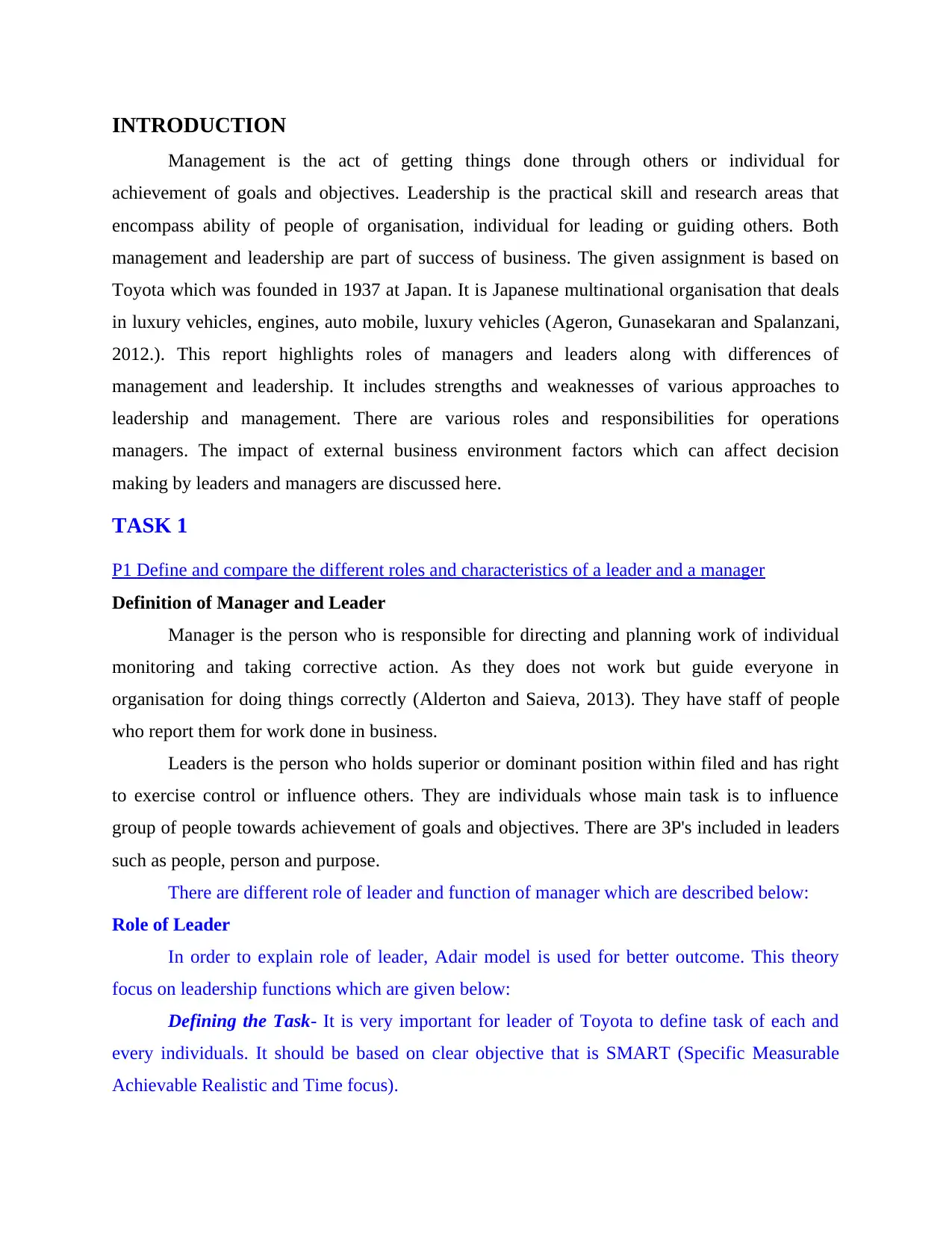
INTRODUCTION
Management is the act of getting things done through others or individual for
achievement of goals and objectives. Leadership is the practical skill and research areas that
encompass ability of people of organisation, individual for leading or guiding others. Both
management and leadership are part of success of business. The given assignment is based on
Toyota which was founded in 1937 at Japan. It is Japanese multinational organisation that deals
in luxury vehicles, engines, auto mobile, luxury vehicles (Ageron, Gunasekaran and Spalanzani,
2012.). This report highlights roles of managers and leaders along with differences of
management and leadership. It includes strengths and weaknesses of various approaches to
leadership and management. There are various roles and responsibilities for operations
managers. The impact of external business environment factors which can affect decision
making by leaders and managers are discussed here.
TASK 1
P1 Define and compare the different roles and characteristics of a leader and a manager
Definition of Manager and Leader
Manager is the person who is responsible for directing and planning work of individual
monitoring and taking corrective action. As they does not work but guide everyone in
organisation for doing things correctly (Alderton and Saieva, 2013). They have staff of people
who report them for work done in business.
Leaders is the person who holds superior or dominant position within filed and has right
to exercise control or influence others. They are individuals whose main task is to influence
group of people towards achievement of goals and objectives. There are 3P's included in leaders
such as people, person and purpose.
There are different role of leader and function of manager which are described below:
Role of Leader
In order to explain role of leader, Adair model is used for better outcome. This theory
focus on leadership functions which are given below:
Defining the Task- It is very important for leader of Toyota to define task of each and
every individuals. It should be based on clear objective that is SMART (Specific Measurable
Achievable Realistic and Time focus).
Management is the act of getting things done through others or individual for
achievement of goals and objectives. Leadership is the practical skill and research areas that
encompass ability of people of organisation, individual for leading or guiding others. Both
management and leadership are part of success of business. The given assignment is based on
Toyota which was founded in 1937 at Japan. It is Japanese multinational organisation that deals
in luxury vehicles, engines, auto mobile, luxury vehicles (Ageron, Gunasekaran and Spalanzani,
2012.). This report highlights roles of managers and leaders along with differences of
management and leadership. It includes strengths and weaknesses of various approaches to
leadership and management. There are various roles and responsibilities for operations
managers. The impact of external business environment factors which can affect decision
making by leaders and managers are discussed here.
TASK 1
P1 Define and compare the different roles and characteristics of a leader and a manager
Definition of Manager and Leader
Manager is the person who is responsible for directing and planning work of individual
monitoring and taking corrective action. As they does not work but guide everyone in
organisation for doing things correctly (Alderton and Saieva, 2013). They have staff of people
who report them for work done in business.
Leaders is the person who holds superior or dominant position within filed and has right
to exercise control or influence others. They are individuals whose main task is to influence
group of people towards achievement of goals and objectives. There are 3P's included in leaders
such as people, person and purpose.
There are different role of leader and function of manager which are described below:
Role of Leader
In order to explain role of leader, Adair model is used for better outcome. This theory
focus on leadership functions which are given below:
Defining the Task- It is very important for leader of Toyota to define task of each and
every individuals. It should be based on clear objective that is SMART (Specific Measurable
Achievable Realistic and Time focus).
⊘ This is a preview!⊘
Do you want full access?
Subscribe today to unlock all pages.

Trusted by 1+ million students worldwide
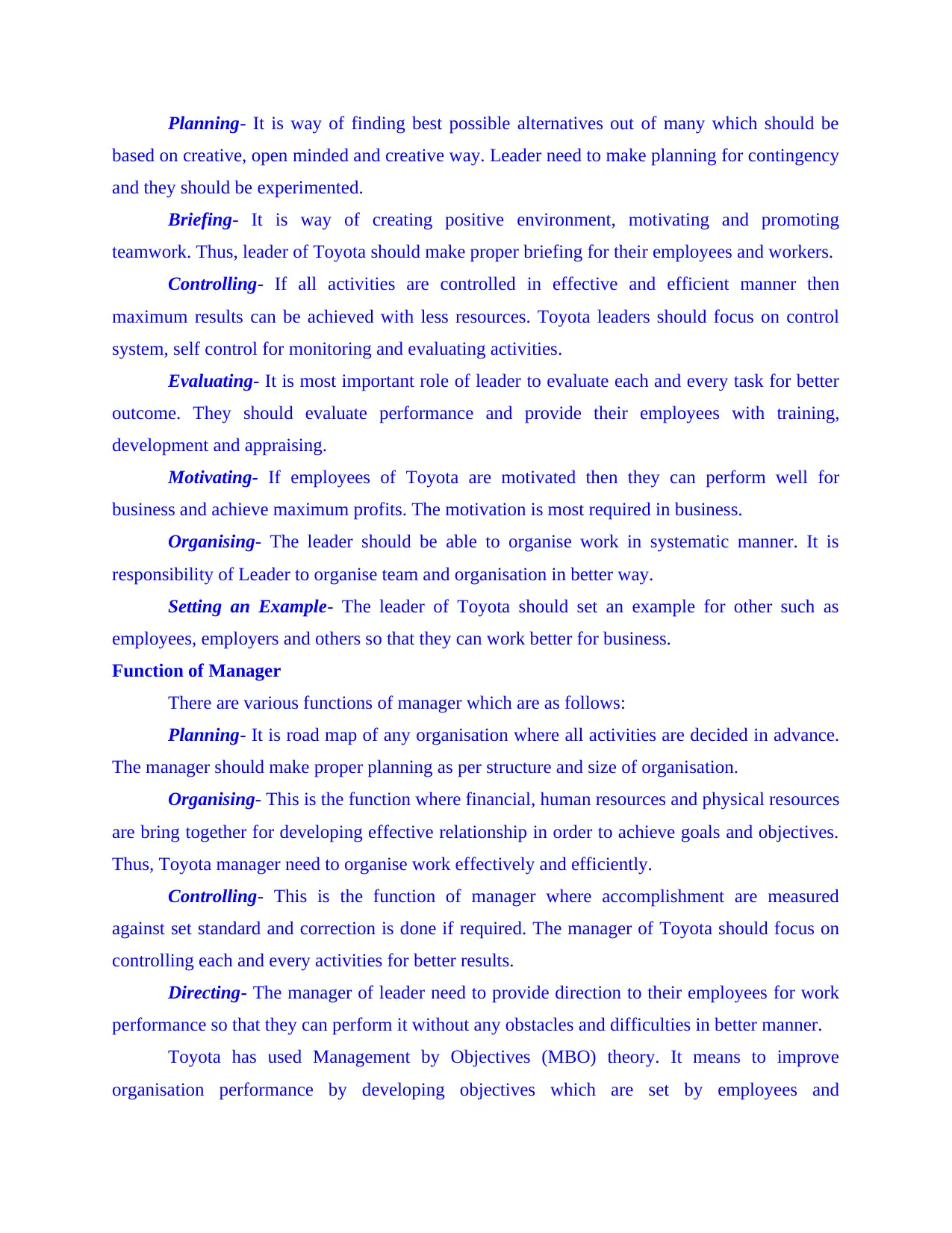
Planning- It is way of finding best possible alternatives out of many which should be
based on creative, open minded and creative way. Leader need to make planning for contingency
and they should be experimented.
Briefing- It is way of creating positive environment, motivating and promoting
teamwork. Thus, leader of Toyota should make proper briefing for their employees and workers.
Controlling- If all activities are controlled in effective and efficient manner then
maximum results can be achieved with less resources. Toyota leaders should focus on control
system, self control for monitoring and evaluating activities.
Evaluating- It is most important role of leader to evaluate each and every task for better
outcome. They should evaluate performance and provide their employees with training,
development and appraising.
Motivating- If employees of Toyota are motivated then they can perform well for
business and achieve maximum profits. The motivation is most required in business.
Organising- The leader should be able to organise work in systematic manner. It is
responsibility of Leader to organise team and organisation in better way.
Setting an Example- The leader of Toyota should set an example for other such as
employees, employers and others so that they can work better for business.
Function of Manager
There are various functions of manager which are as follows:
Planning- It is road map of any organisation where all activities are decided in advance.
The manager should make proper planning as per structure and size of organisation.
Organising- This is the function where financial, human resources and physical resources
are bring together for developing effective relationship in order to achieve goals and objectives.
Thus, Toyota manager need to organise work effectively and efficiently.
Controlling- This is the function of manager where accomplishment are measured
against set standard and correction is done if required. The manager of Toyota should focus on
controlling each and every activities for better results.
Directing- The manager of leader need to provide direction to their employees for work
performance so that they can perform it without any obstacles and difficulties in better manner.
Toyota has used Management by Objectives (MBO) theory. It means to improve
organisation performance by developing objectives which are set by employees and
based on creative, open minded and creative way. Leader need to make planning for contingency
and they should be experimented.
Briefing- It is way of creating positive environment, motivating and promoting
teamwork. Thus, leader of Toyota should make proper briefing for their employees and workers.
Controlling- If all activities are controlled in effective and efficient manner then
maximum results can be achieved with less resources. Toyota leaders should focus on control
system, self control for monitoring and evaluating activities.
Evaluating- It is most important role of leader to evaluate each and every task for better
outcome. They should evaluate performance and provide their employees with training,
development and appraising.
Motivating- If employees of Toyota are motivated then they can perform well for
business and achieve maximum profits. The motivation is most required in business.
Organising- The leader should be able to organise work in systematic manner. It is
responsibility of Leader to organise team and organisation in better way.
Setting an Example- The leader of Toyota should set an example for other such as
employees, employers and others so that they can work better for business.
Function of Manager
There are various functions of manager which are as follows:
Planning- It is road map of any organisation where all activities are decided in advance.
The manager should make proper planning as per structure and size of organisation.
Organising- This is the function where financial, human resources and physical resources
are bring together for developing effective relationship in order to achieve goals and objectives.
Thus, Toyota manager need to organise work effectively and efficiently.
Controlling- This is the function of manager where accomplishment are measured
against set standard and correction is done if required. The manager of Toyota should focus on
controlling each and every activities for better results.
Directing- The manager of leader need to provide direction to their employees for work
performance so that they can perform it without any obstacles and difficulties in better manner.
Toyota has used Management by Objectives (MBO) theory. It means to improve
organisation performance by developing objectives which are set by employees and
Paraphrase This Document
Need a fresh take? Get an instant paraphrase of this document with our AI Paraphraser
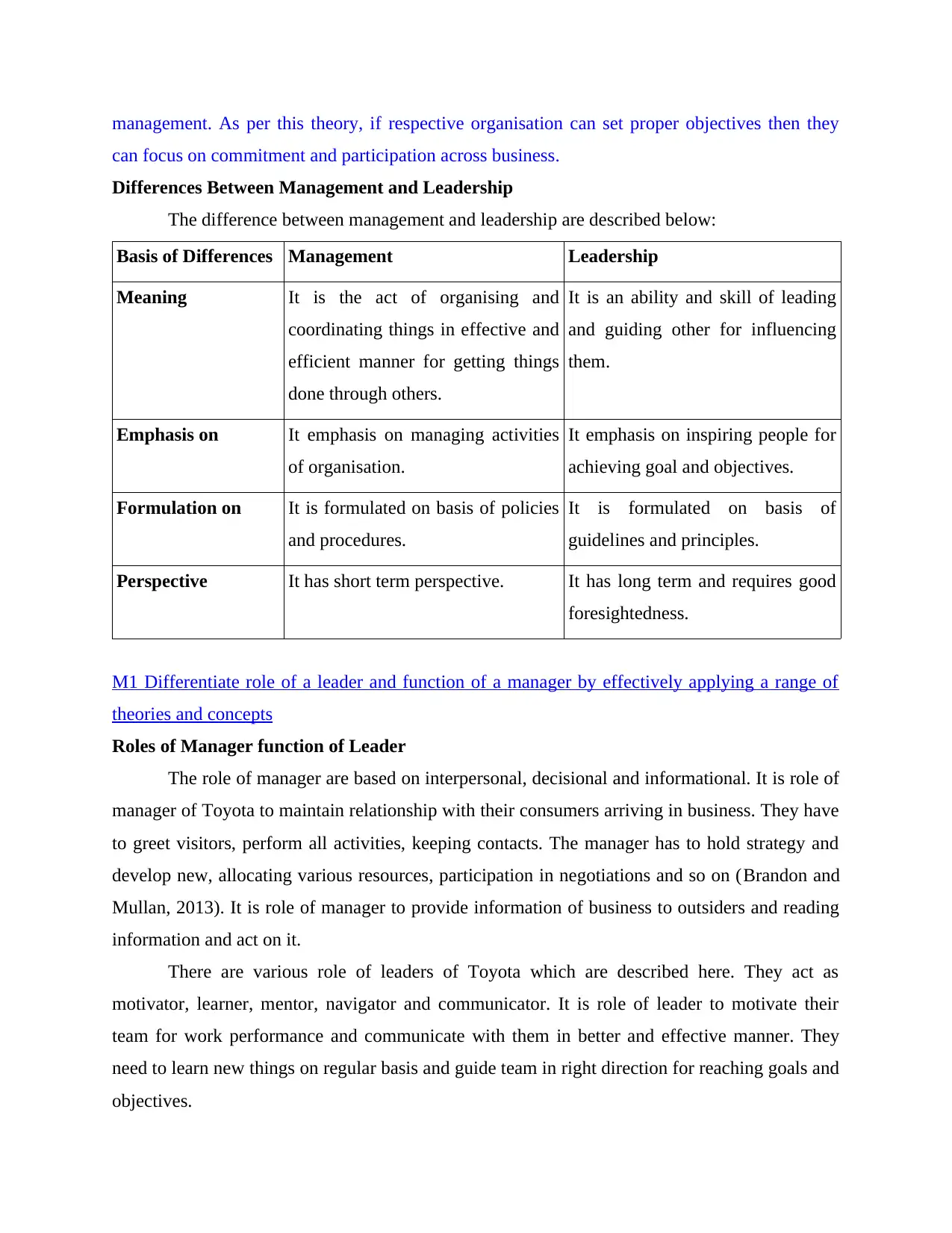
management. As per this theory, if respective organisation can set proper objectives then they
can focus on commitment and participation across business.
Differences Between Management and Leadership
The difference between management and leadership are described below:
Basis of Differences Management Leadership
Meaning It is the act of organising and
coordinating things in effective and
efficient manner for getting things
done through others.
It is an ability and skill of leading
and guiding other for influencing
them.
Emphasis on It emphasis on managing activities
of organisation.
It emphasis on inspiring people for
achieving goal and objectives.
Formulation on It is formulated on basis of policies
and procedures.
It is formulated on basis of
guidelines and principles.
Perspective It has short term perspective. It has long term and requires good
foresightedness.
M1 Differentiate role of a leader and function of a manager by effectively applying a range of
theories and concepts
Roles of Manager function of Leader
The role of manager are based on interpersonal, decisional and informational. It is role of
manager of Toyota to maintain relationship with their consumers arriving in business. They have
to greet visitors, perform all activities, keeping contacts. The manager has to hold strategy and
develop new, allocating various resources, participation in negotiations and so on (Brandon and
Mullan, 2013). It is role of manager to provide information of business to outsiders and reading
information and act on it.
There are various role of leaders of Toyota which are described here. They act as
motivator, learner, mentor, navigator and communicator. It is role of leader to motivate their
team for work performance and communicate with them in better and effective manner. They
need to learn new things on regular basis and guide team in right direction for reaching goals and
objectives.
can focus on commitment and participation across business.
Differences Between Management and Leadership
The difference between management and leadership are described below:
Basis of Differences Management Leadership
Meaning It is the act of organising and
coordinating things in effective and
efficient manner for getting things
done through others.
It is an ability and skill of leading
and guiding other for influencing
them.
Emphasis on It emphasis on managing activities
of organisation.
It emphasis on inspiring people for
achieving goal and objectives.
Formulation on It is formulated on basis of policies
and procedures.
It is formulated on basis of
guidelines and principles.
Perspective It has short term perspective. It has long term and requires good
foresightedness.
M1 Differentiate role of a leader and function of a manager by effectively applying a range of
theories and concepts
Roles of Manager function of Leader
The role of manager are based on interpersonal, decisional and informational. It is role of
manager of Toyota to maintain relationship with their consumers arriving in business. They have
to greet visitors, perform all activities, keeping contacts. The manager has to hold strategy and
develop new, allocating various resources, participation in negotiations and so on (Brandon and
Mullan, 2013). It is role of manager to provide information of business to outsiders and reading
information and act on it.
There are various role of leaders of Toyota which are described here. They act as
motivator, learner, mentor, navigator and communicator. It is role of leader to motivate their
team for work performance and communicate with them in better and effective manner. They
need to learn new things on regular basis and guide team in right direction for reaching goals and
objectives.
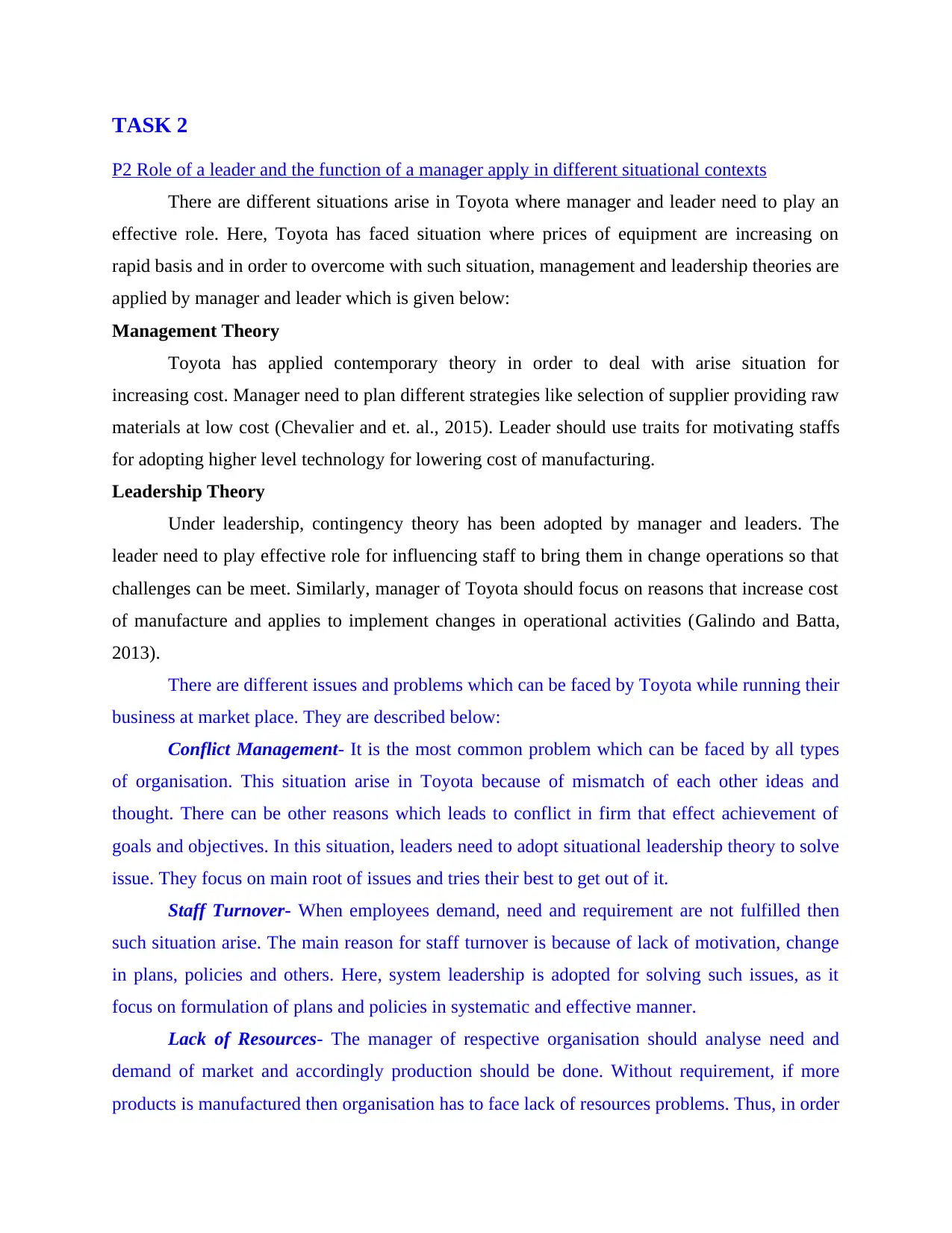
TASK 2
P2 Role of a leader and the function of a manager apply in different situational contexts
There are different situations arise in Toyota where manager and leader need to play an
effective role. Here, Toyota has faced situation where prices of equipment are increasing on
rapid basis and in order to overcome with such situation, management and leadership theories are
applied by manager and leader which is given below:
Management Theory
Toyota has applied contemporary theory in order to deal with arise situation for
increasing cost. Manager need to plan different strategies like selection of supplier providing raw
materials at low cost (Chevalier and et. al., 2015). Leader should use traits for motivating staffs
for adopting higher level technology for lowering cost of manufacturing.
Leadership Theory
Under leadership, contingency theory has been adopted by manager and leaders. The
leader need to play effective role for influencing staff to bring them in change operations so that
challenges can be meet. Similarly, manager of Toyota should focus on reasons that increase cost
of manufacture and applies to implement changes in operational activities (Galindo and Batta,
2013).
There are different issues and problems which can be faced by Toyota while running their
business at market place. They are described below:
Conflict Management- It is the most common problem which can be faced by all types
of organisation. This situation arise in Toyota because of mismatch of each other ideas and
thought. There can be other reasons which leads to conflict in firm that effect achievement of
goals and objectives. In this situation, leaders need to adopt situational leadership theory to solve
issue. They focus on main root of issues and tries their best to get out of it.
Staff Turnover- When employees demand, need and requirement are not fulfilled then
such situation arise. The main reason for staff turnover is because of lack of motivation, change
in plans, policies and others. Here, system leadership is adopted for solving such issues, as it
focus on formulation of plans and policies in systematic and effective manner.
Lack of Resources- The manager of respective organisation should analyse need and
demand of market and accordingly production should be done. Without requirement, if more
products is manufactured then organisation has to face lack of resources problems. Thus, in order
P2 Role of a leader and the function of a manager apply in different situational contexts
There are different situations arise in Toyota where manager and leader need to play an
effective role. Here, Toyota has faced situation where prices of equipment are increasing on
rapid basis and in order to overcome with such situation, management and leadership theories are
applied by manager and leader which is given below:
Management Theory
Toyota has applied contemporary theory in order to deal with arise situation for
increasing cost. Manager need to plan different strategies like selection of supplier providing raw
materials at low cost (Chevalier and et. al., 2015). Leader should use traits for motivating staffs
for adopting higher level technology for lowering cost of manufacturing.
Leadership Theory
Under leadership, contingency theory has been adopted by manager and leaders. The
leader need to play effective role for influencing staff to bring them in change operations so that
challenges can be meet. Similarly, manager of Toyota should focus on reasons that increase cost
of manufacture and applies to implement changes in operational activities (Galindo and Batta,
2013).
There are different issues and problems which can be faced by Toyota while running their
business at market place. They are described below:
Conflict Management- It is the most common problem which can be faced by all types
of organisation. This situation arise in Toyota because of mismatch of each other ideas and
thought. There can be other reasons which leads to conflict in firm that effect achievement of
goals and objectives. In this situation, leaders need to adopt situational leadership theory to solve
issue. They focus on main root of issues and tries their best to get out of it.
Staff Turnover- When employees demand, need and requirement are not fulfilled then
such situation arise. The main reason for staff turnover is because of lack of motivation, change
in plans, policies and others. Here, system leadership is adopted for solving such issues, as it
focus on formulation of plans and policies in systematic and effective manner.
Lack of Resources- The manager of respective organisation should analyse need and
demand of market and accordingly production should be done. Without requirement, if more
products is manufactured then organisation has to face lack of resources problems. Thus, in order
⊘ This is a preview!⊘
Do you want full access?
Subscribe today to unlock all pages.

Trusted by 1+ million students worldwide
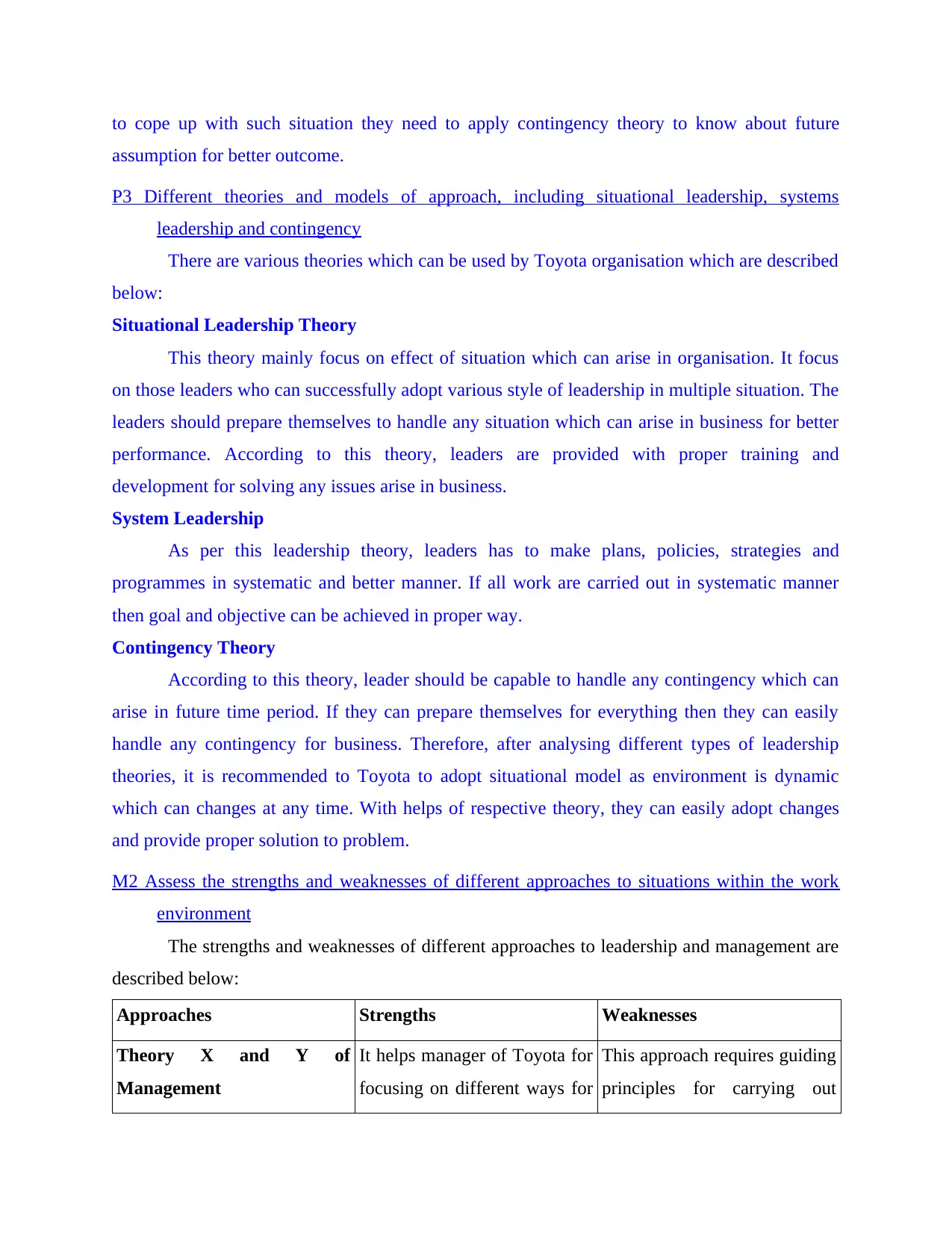
to cope up with such situation they need to apply contingency theory to know about future
assumption for better outcome.
P3 Different theories and models of approach, including situational leadership, systems
leadership and contingency
There are various theories which can be used by Toyota organisation which are described
below:
Situational Leadership Theory
This theory mainly focus on effect of situation which can arise in organisation. It focus
on those leaders who can successfully adopt various style of leadership in multiple situation. The
leaders should prepare themselves to handle any situation which can arise in business for better
performance. According to this theory, leaders are provided with proper training and
development for solving any issues arise in business.
System Leadership
As per this leadership theory, leaders has to make plans, policies, strategies and
programmes in systematic and better manner. If all work are carried out in systematic manner
then goal and objective can be achieved in proper way.
Contingency Theory
According to this theory, leader should be capable to handle any contingency which can
arise in future time period. If they can prepare themselves for everything then they can easily
handle any contingency for business. Therefore, after analysing different types of leadership
theories, it is recommended to Toyota to adopt situational model as environment is dynamic
which can changes at any time. With helps of respective theory, they can easily adopt changes
and provide proper solution to problem.
M2 Assess the strengths and weaknesses of different approaches to situations within the work
environment
The strengths and weaknesses of different approaches to leadership and management are
described below:
Approaches Strengths Weaknesses
Theory X and Y of
Management
It helps manager of Toyota for
focusing on different ways for
This approach requires guiding
principles for carrying out
assumption for better outcome.
P3 Different theories and models of approach, including situational leadership, systems
leadership and contingency
There are various theories which can be used by Toyota organisation which are described
below:
Situational Leadership Theory
This theory mainly focus on effect of situation which can arise in organisation. It focus
on those leaders who can successfully adopt various style of leadership in multiple situation. The
leaders should prepare themselves to handle any situation which can arise in business for better
performance. According to this theory, leaders are provided with proper training and
development for solving any issues arise in business.
System Leadership
As per this leadership theory, leaders has to make plans, policies, strategies and
programmes in systematic and better manner. If all work are carried out in systematic manner
then goal and objective can be achieved in proper way.
Contingency Theory
According to this theory, leader should be capable to handle any contingency which can
arise in future time period. If they can prepare themselves for everything then they can easily
handle any contingency for business. Therefore, after analysing different types of leadership
theories, it is recommended to Toyota to adopt situational model as environment is dynamic
which can changes at any time. With helps of respective theory, they can easily adopt changes
and provide proper solution to problem.
M2 Assess the strengths and weaknesses of different approaches to situations within the work
environment
The strengths and weaknesses of different approaches to leadership and management are
described below:
Approaches Strengths Weaknesses
Theory X and Y of
Management
It helps manager of Toyota for
focusing on different ways for
This approach requires guiding
principles for carrying out
Paraphrase This Document
Need a fresh take? Get an instant paraphrase of this document with our AI Paraphraser
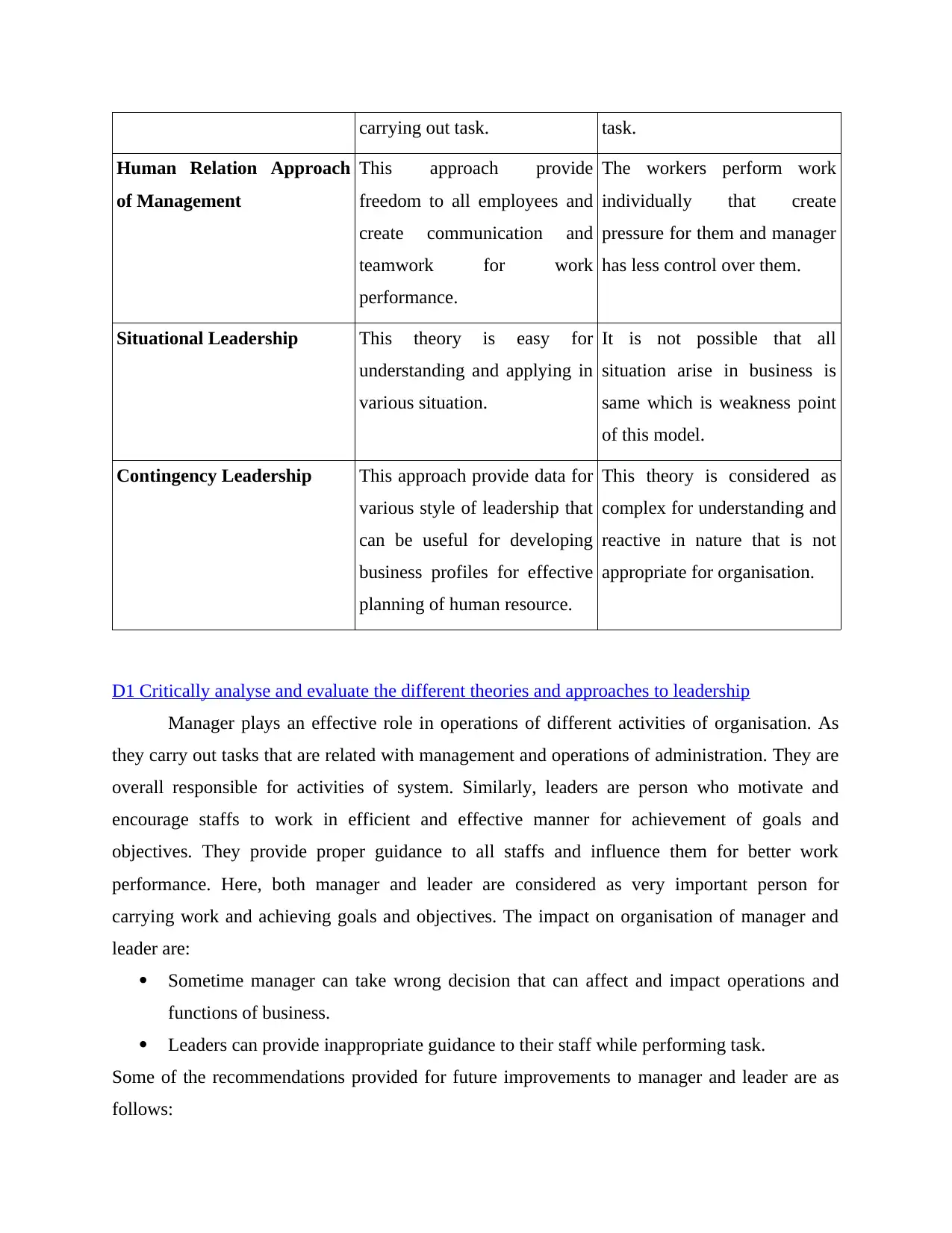
carrying out task. task.
Human Relation Approach
of Management
This approach provide
freedom to all employees and
create communication and
teamwork for work
performance.
The workers perform work
individually that create
pressure for them and manager
has less control over them.
Situational Leadership This theory is easy for
understanding and applying in
various situation.
It is not possible that all
situation arise in business is
same which is weakness point
of this model.
Contingency Leadership This approach provide data for
various style of leadership that
can be useful for developing
business profiles for effective
planning of human resource.
This theory is considered as
complex for understanding and
reactive in nature that is not
appropriate for organisation.
D1 Critically analyse and evaluate the different theories and approaches to leadership
Manager plays an effective role in operations of different activities of organisation. As
they carry out tasks that are related with management and operations of administration. They are
overall responsible for activities of system. Similarly, leaders are person who motivate and
encourage staffs to work in efficient and effective manner for achievement of goals and
objectives. They provide proper guidance to all staffs and influence them for better work
performance. Here, both manager and leader are considered as very important person for
carrying work and achieving goals and objectives. The impact on organisation of manager and
leader are:
Sometime manager can take wrong decision that can affect and impact operations and
functions of business.
Leaders can provide inappropriate guidance to their staff while performing task.
Some of the recommendations provided for future improvements to manager and leader are as
follows:
Human Relation Approach
of Management
This approach provide
freedom to all employees and
create communication and
teamwork for work
performance.
The workers perform work
individually that create
pressure for them and manager
has less control over them.
Situational Leadership This theory is easy for
understanding and applying in
various situation.
It is not possible that all
situation arise in business is
same which is weakness point
of this model.
Contingency Leadership This approach provide data for
various style of leadership that
can be useful for developing
business profiles for effective
planning of human resource.
This theory is considered as
complex for understanding and
reactive in nature that is not
appropriate for organisation.
D1 Critically analyse and evaluate the different theories and approaches to leadership
Manager plays an effective role in operations of different activities of organisation. As
they carry out tasks that are related with management and operations of administration. They are
overall responsible for activities of system. Similarly, leaders are person who motivate and
encourage staffs to work in efficient and effective manner for achievement of goals and
objectives. They provide proper guidance to all staffs and influence them for better work
performance. Here, both manager and leader are considered as very important person for
carrying work and achieving goals and objectives. The impact on organisation of manager and
leader are:
Sometime manager can take wrong decision that can affect and impact operations and
functions of business.
Leaders can provide inappropriate guidance to their staff while performing task.
Some of the recommendations provided for future improvements to manager and leader are as
follows:
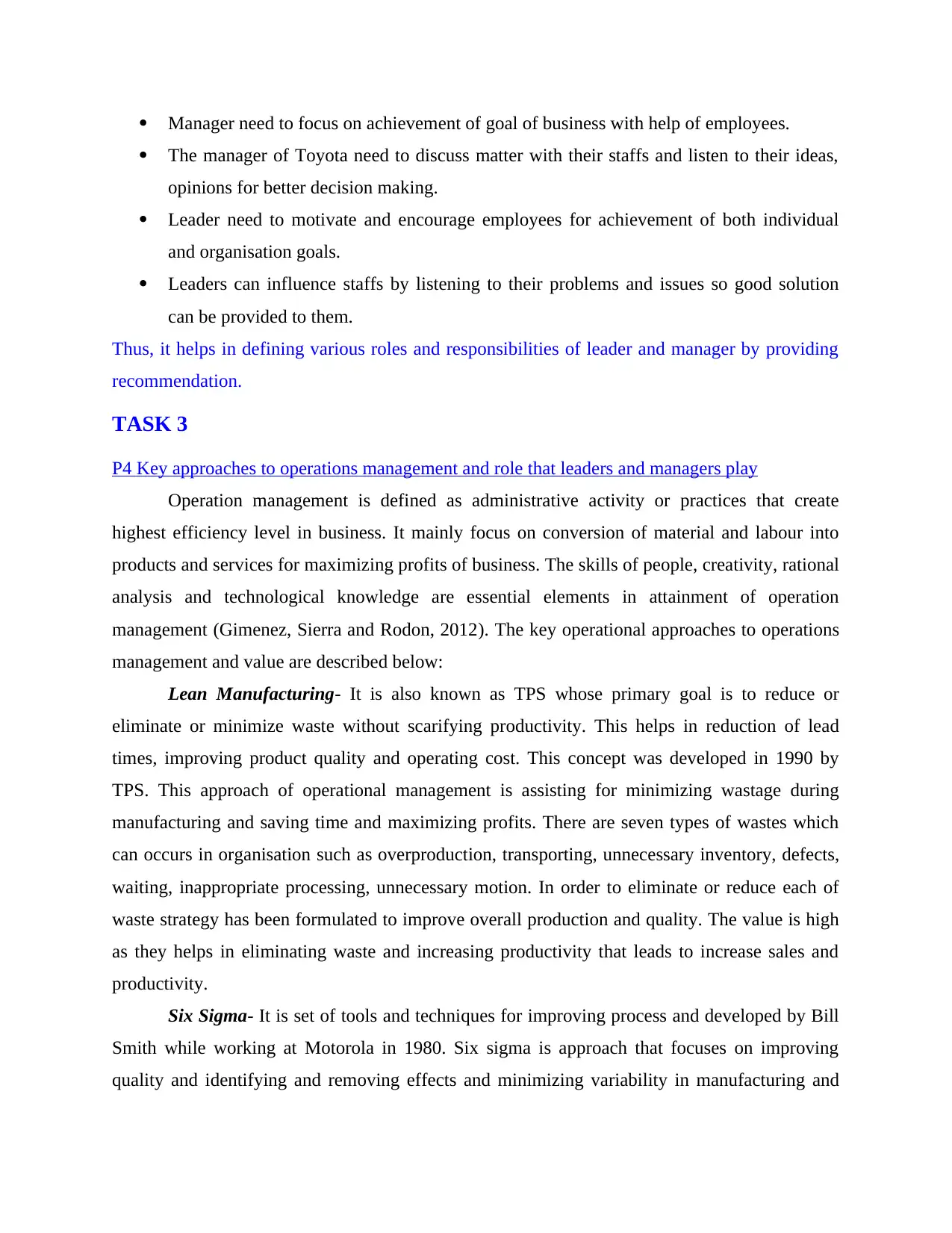
Manager need to focus on achievement of goal of business with help of employees.
The manager of Toyota need to discuss matter with their staffs and listen to their ideas,
opinions for better decision making.
Leader need to motivate and encourage employees for achievement of both individual
and organisation goals.
Leaders can influence staffs by listening to their problems and issues so good solution
can be provided to them.
Thus, it helps in defining various roles and responsibilities of leader and manager by providing
recommendation.
TASK 3
P4 Key approaches to operations management and role that leaders and managers play
Operation management is defined as administrative activity or practices that create
highest efficiency level in business. It mainly focus on conversion of material and labour into
products and services for maximizing profits of business. The skills of people, creativity, rational
analysis and technological knowledge are essential elements in attainment of operation
management (Gimenez, Sierra and Rodon, 2012). The key operational approaches to operations
management and value are described below:
Lean Manufacturing- It is also known as TPS whose primary goal is to reduce or
eliminate or minimize waste without scarifying productivity. This helps in reduction of lead
times, improving product quality and operating cost. This concept was developed in 1990 by
TPS. This approach of operational management is assisting for minimizing wastage during
manufacturing and saving time and maximizing profits. There are seven types of wastes which
can occurs in organisation such as overproduction, transporting, unnecessary inventory, defects,
waiting, inappropriate processing, unnecessary motion. In order to eliminate or reduce each of
waste strategy has been formulated to improve overall production and quality. The value is high
as they helps in eliminating waste and increasing productivity that leads to increase sales and
productivity.
Six Sigma- It is set of tools and techniques for improving process and developed by Bill
Smith while working at Motorola in 1980. Six sigma is approach that focuses on improving
quality and identifying and removing effects and minimizing variability in manufacturing and
The manager of Toyota need to discuss matter with their staffs and listen to their ideas,
opinions for better decision making.
Leader need to motivate and encourage employees for achievement of both individual
and organisation goals.
Leaders can influence staffs by listening to their problems and issues so good solution
can be provided to them.
Thus, it helps in defining various roles and responsibilities of leader and manager by providing
recommendation.
TASK 3
P4 Key approaches to operations management and role that leaders and managers play
Operation management is defined as administrative activity or practices that create
highest efficiency level in business. It mainly focus on conversion of material and labour into
products and services for maximizing profits of business. The skills of people, creativity, rational
analysis and technological knowledge are essential elements in attainment of operation
management (Gimenez, Sierra and Rodon, 2012). The key operational approaches to operations
management and value are described below:
Lean Manufacturing- It is also known as TPS whose primary goal is to reduce or
eliminate or minimize waste without scarifying productivity. This helps in reduction of lead
times, improving product quality and operating cost. This concept was developed in 1990 by
TPS. This approach of operational management is assisting for minimizing wastage during
manufacturing and saving time and maximizing profits. There are seven types of wastes which
can occurs in organisation such as overproduction, transporting, unnecessary inventory, defects,
waiting, inappropriate processing, unnecessary motion. In order to eliminate or reduce each of
waste strategy has been formulated to improve overall production and quality. The value is high
as they helps in eliminating waste and increasing productivity that leads to increase sales and
productivity.
Six Sigma- It is set of tools and techniques for improving process and developed by Bill
Smith while working at Motorola in 1980. Six sigma is approach that focuses on improving
quality and identifying and removing effects and minimizing variability in manufacturing and
⊘ This is a preview!⊘
Do you want full access?
Subscribe today to unlock all pages.

Trusted by 1+ million students worldwide
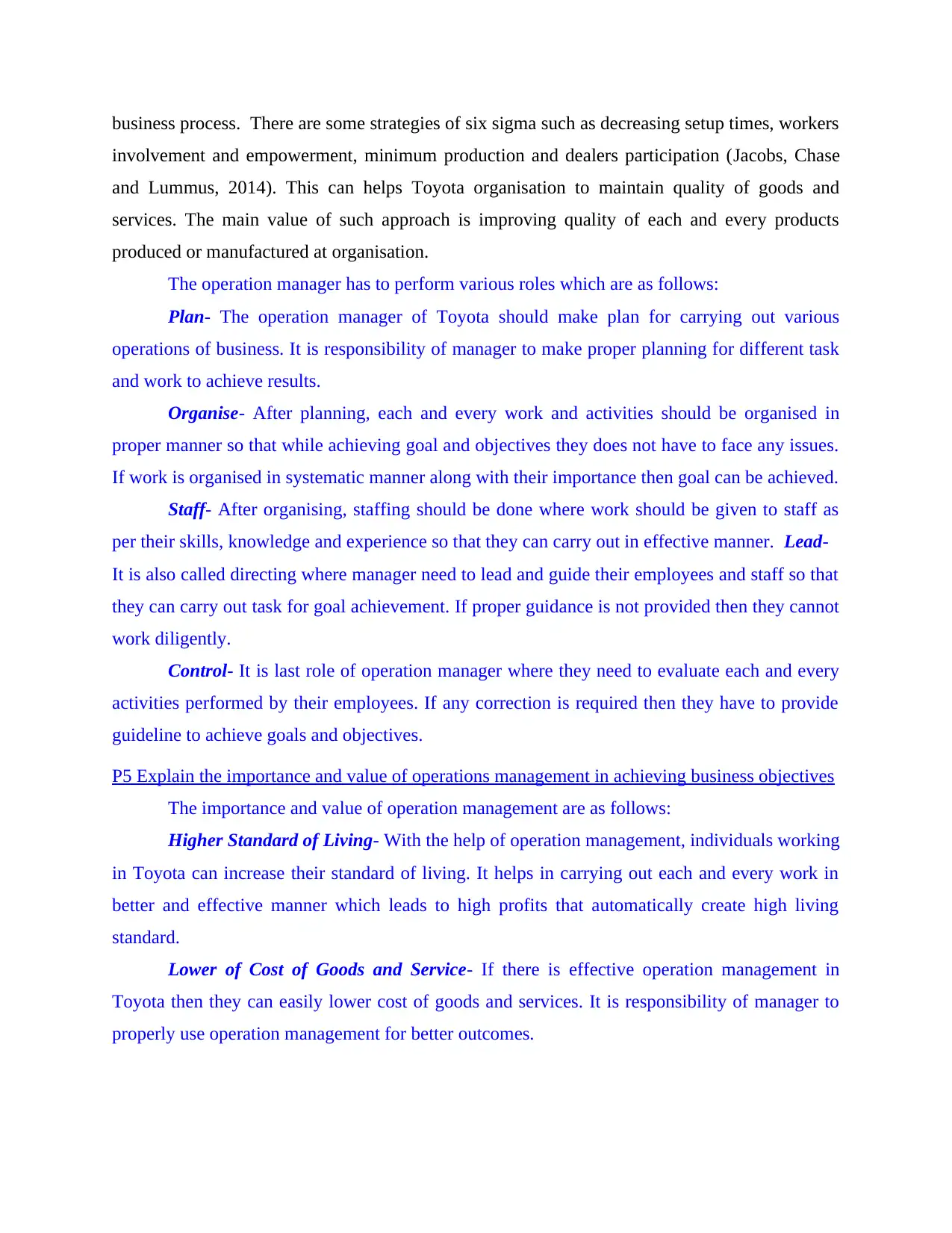
business process. There are some strategies of six sigma such as decreasing setup times, workers
involvement and empowerment, minimum production and dealers participation (Jacobs, Chase
and Lummus, 2014). This can helps Toyota organisation to maintain quality of goods and
services. The main value of such approach is improving quality of each and every products
produced or manufactured at organisation.
The operation manager has to perform various roles which are as follows:
Plan- The operation manager of Toyota should make plan for carrying out various
operations of business. It is responsibility of manager to make proper planning for different task
and work to achieve results.
Organise- After planning, each and every work and activities should be organised in
proper manner so that while achieving goal and objectives they does not have to face any issues.
If work is organised in systematic manner along with their importance then goal can be achieved.
Staff- After organising, staffing should be done where work should be given to staff as
per their skills, knowledge and experience so that they can carry out in effective manner. Lead-
It is also called directing where manager need to lead and guide their employees and staff so that
they can carry out task for goal achievement. If proper guidance is not provided then they cannot
work diligently.
Control- It is last role of operation manager where they need to evaluate each and every
activities performed by their employees. If any correction is required then they have to provide
guideline to achieve goals and objectives.
P5 Explain the importance and value of operations management in achieving business objectives
The importance and value of operation management are as follows:
Higher Standard of Living- With the help of operation management, individuals working
in Toyota can increase their standard of living. It helps in carrying out each and every work in
better and effective manner which leads to high profits that automatically create high living
standard.
Lower of Cost of Goods and Service- If there is effective operation management in
Toyota then they can easily lower cost of goods and services. It is responsibility of manager to
properly use operation management for better outcomes.
involvement and empowerment, minimum production and dealers participation (Jacobs, Chase
and Lummus, 2014). This can helps Toyota organisation to maintain quality of goods and
services. The main value of such approach is improving quality of each and every products
produced or manufactured at organisation.
The operation manager has to perform various roles which are as follows:
Plan- The operation manager of Toyota should make plan for carrying out various
operations of business. It is responsibility of manager to make proper planning for different task
and work to achieve results.
Organise- After planning, each and every work and activities should be organised in
proper manner so that while achieving goal and objectives they does not have to face any issues.
If work is organised in systematic manner along with their importance then goal can be achieved.
Staff- After organising, staffing should be done where work should be given to staff as
per their skills, knowledge and experience so that they can carry out in effective manner. Lead-
It is also called directing where manager need to lead and guide their employees and staff so that
they can carry out task for goal achievement. If proper guidance is not provided then they cannot
work diligently.
Control- It is last role of operation manager where they need to evaluate each and every
activities performed by their employees. If any correction is required then they have to provide
guideline to achieve goals and objectives.
P5 Explain the importance and value of operations management in achieving business objectives
The importance and value of operation management are as follows:
Higher Standard of Living- With the help of operation management, individuals working
in Toyota can increase their standard of living. It helps in carrying out each and every work in
better and effective manner which leads to high profits that automatically create high living
standard.
Lower of Cost of Goods and Service- If there is effective operation management in
Toyota then they can easily lower cost of goods and services. It is responsibility of manager to
properly use operation management for better outcomes.
Paraphrase This Document
Need a fresh take? Get an instant paraphrase of this document with our AI Paraphraser
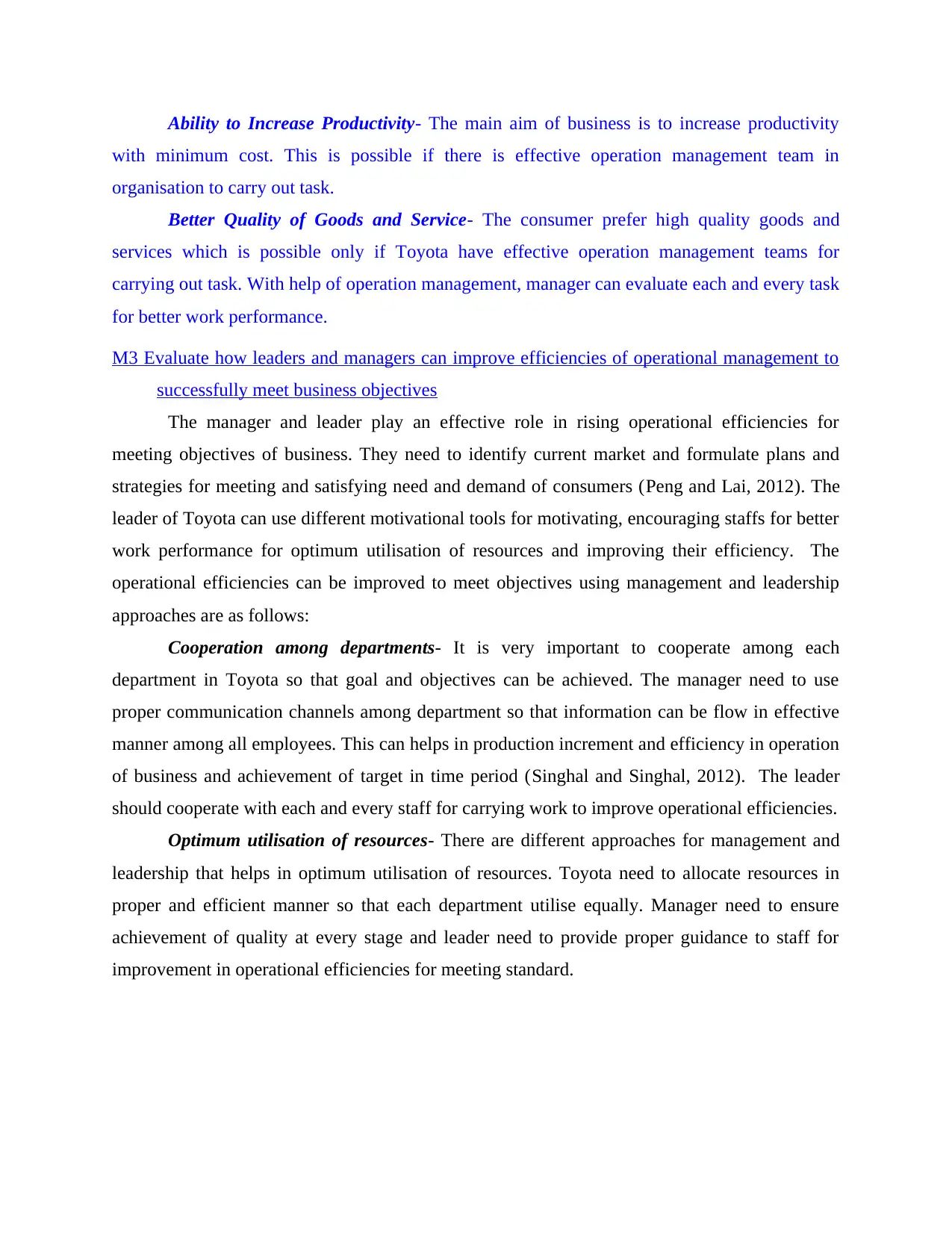
Ability to Increase Productivity- The main aim of business is to increase productivity
with minimum cost. This is possible if there is effective operation management team in
organisation to carry out task.
Better Quality of Goods and Service- The consumer prefer high quality goods and
services which is possible only if Toyota have effective operation management teams for
carrying out task. With help of operation management, manager can evaluate each and every task
for better work performance.
M3 Evaluate how leaders and managers can improve efficiencies of operational management to
successfully meet business objectives
The manager and leader play an effective role in rising operational efficiencies for
meeting objectives of business. They need to identify current market and formulate plans and
strategies for meeting and satisfying need and demand of consumers (Peng and Lai, 2012). The
leader of Toyota can use different motivational tools for motivating, encouraging staffs for better
work performance for optimum utilisation of resources and improving their efficiency. The
operational efficiencies can be improved to meet objectives using management and leadership
approaches are as follows:
Cooperation among departments- It is very important to cooperate among each
department in Toyota so that goal and objectives can be achieved. The manager need to use
proper communication channels among department so that information can be flow in effective
manner among all employees. This can helps in production increment and efficiency in operation
of business and achievement of target in time period (Singhal and Singhal, 2012). The leader
should cooperate with each and every staff for carrying work to improve operational efficiencies.
Optimum utilisation of resources- There are different approaches for management and
leadership that helps in optimum utilisation of resources. Toyota need to allocate resources in
proper and efficient manner so that each department utilise equally. Manager need to ensure
achievement of quality at every stage and leader need to provide proper guidance to staff for
improvement in operational efficiencies for meeting standard.
with minimum cost. This is possible if there is effective operation management team in
organisation to carry out task.
Better Quality of Goods and Service- The consumer prefer high quality goods and
services which is possible only if Toyota have effective operation management teams for
carrying out task. With help of operation management, manager can evaluate each and every task
for better work performance.
M3 Evaluate how leaders and managers can improve efficiencies of operational management to
successfully meet business objectives
The manager and leader play an effective role in rising operational efficiencies for
meeting objectives of business. They need to identify current market and formulate plans and
strategies for meeting and satisfying need and demand of consumers (Peng and Lai, 2012). The
leader of Toyota can use different motivational tools for motivating, encouraging staffs for better
work performance for optimum utilisation of resources and improving their efficiency. The
operational efficiencies can be improved to meet objectives using management and leadership
approaches are as follows:
Cooperation among departments- It is very important to cooperate among each
department in Toyota so that goal and objectives can be achieved. The manager need to use
proper communication channels among department so that information can be flow in effective
manner among all employees. This can helps in production increment and efficiency in operation
of business and achievement of target in time period (Singhal and Singhal, 2012). The leader
should cooperate with each and every staff for carrying work to improve operational efficiencies.
Optimum utilisation of resources- There are different approaches for management and
leadership that helps in optimum utilisation of resources. Toyota need to allocate resources in
proper and efficient manner so that each department utilise equally. Manager need to ensure
achievement of quality at every stage and leader need to provide proper guidance to staff for
improvement in operational efficiencies for meeting standard.
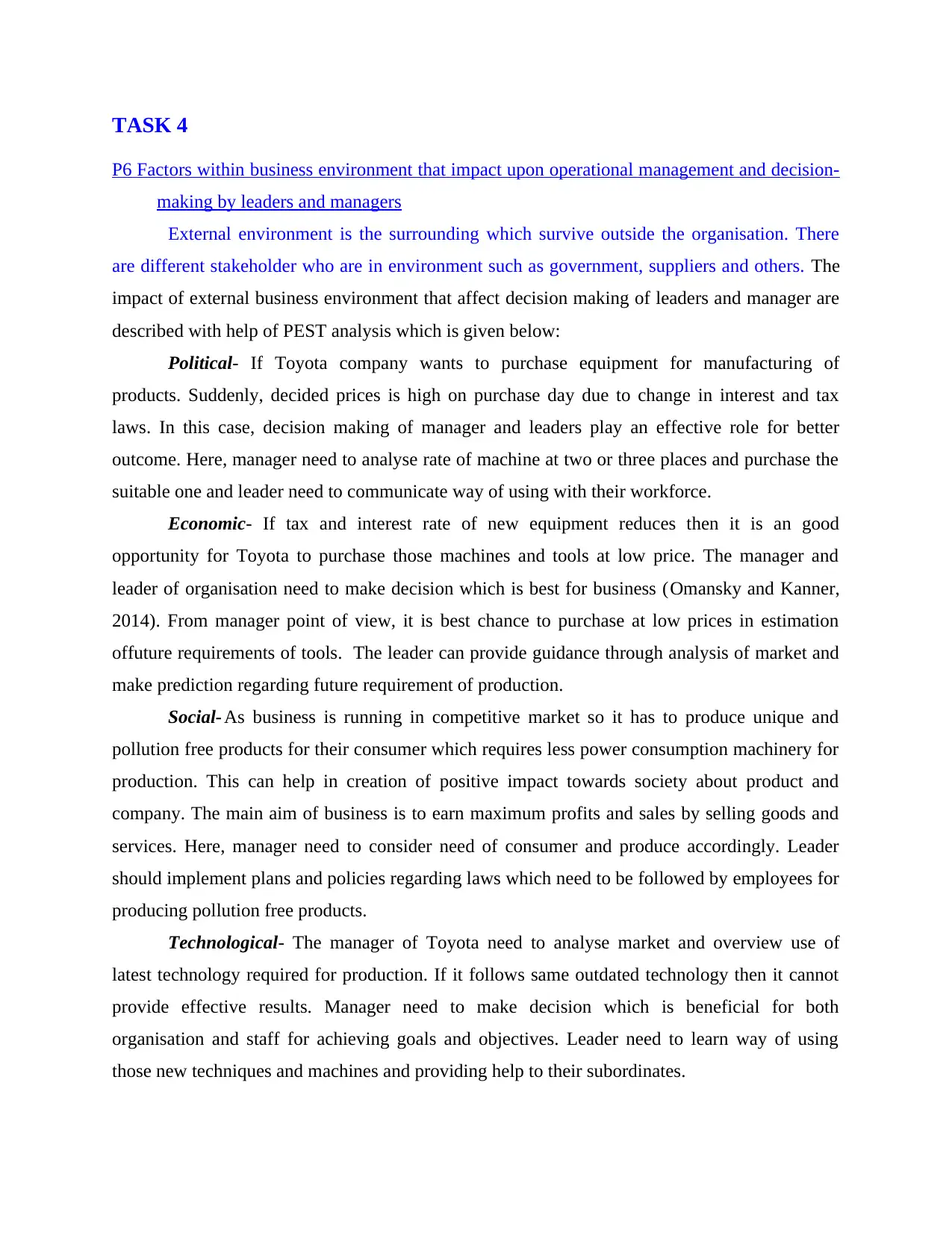
TASK 4
P6 Factors within business environment that impact upon operational management and decision-
making by leaders and managers
External environment is the surrounding which survive outside the organisation. There
are different stakeholder who are in environment such as government, suppliers and others. The
impact of external business environment that affect decision making of leaders and manager are
described with help of PEST analysis which is given below:
Political- If Toyota company wants to purchase equipment for manufacturing of
products. Suddenly, decided prices is high on purchase day due to change in interest and tax
laws. In this case, decision making of manager and leaders play an effective role for better
outcome. Here, manager need to analyse rate of machine at two or three places and purchase the
suitable one and leader need to communicate way of using with their workforce.
Economic- If tax and interest rate of new equipment reduces then it is an good
opportunity for Toyota to purchase those machines and tools at low price. The manager and
leader of organisation need to make decision which is best for business (Omansky and Kanner,
2014). From manager point of view, it is best chance to purchase at low prices in estimation
offuture requirements of tools. The leader can provide guidance through analysis of market and
make prediction regarding future requirement of production.
Social- As business is running in competitive market so it has to produce unique and
pollution free products for their consumer which requires less power consumption machinery for
production. This can help in creation of positive impact towards society about product and
company. The main aim of business is to earn maximum profits and sales by selling goods and
services. Here, manager need to consider need of consumer and produce accordingly. Leader
should implement plans and policies regarding laws which need to be followed by employees for
producing pollution free products.
Technological- The manager of Toyota need to analyse market and overview use of
latest technology required for production. If it follows same outdated technology then it cannot
provide effective results. Manager need to make decision which is beneficial for both
organisation and staff for achieving goals and objectives. Leader need to learn way of using
those new techniques and machines and providing help to their subordinates.
P6 Factors within business environment that impact upon operational management and decision-
making by leaders and managers
External environment is the surrounding which survive outside the organisation. There
are different stakeholder who are in environment such as government, suppliers and others. The
impact of external business environment that affect decision making of leaders and manager are
described with help of PEST analysis which is given below:
Political- If Toyota company wants to purchase equipment for manufacturing of
products. Suddenly, decided prices is high on purchase day due to change in interest and tax
laws. In this case, decision making of manager and leaders play an effective role for better
outcome. Here, manager need to analyse rate of machine at two or three places and purchase the
suitable one and leader need to communicate way of using with their workforce.
Economic- If tax and interest rate of new equipment reduces then it is an good
opportunity for Toyota to purchase those machines and tools at low price. The manager and
leader of organisation need to make decision which is best for business (Omansky and Kanner,
2014). From manager point of view, it is best chance to purchase at low prices in estimation
offuture requirements of tools. The leader can provide guidance through analysis of market and
make prediction regarding future requirement of production.
Social- As business is running in competitive market so it has to produce unique and
pollution free products for their consumer which requires less power consumption machinery for
production. This can help in creation of positive impact towards society about product and
company. The main aim of business is to earn maximum profits and sales by selling goods and
services. Here, manager need to consider need of consumer and produce accordingly. Leader
should implement plans and policies regarding laws which need to be followed by employees for
producing pollution free products.
Technological- The manager of Toyota need to analyse market and overview use of
latest technology required for production. If it follows same outdated technology then it cannot
provide effective results. Manager need to make decision which is beneficial for both
organisation and staff for achieving goals and objectives. Leader need to learn way of using
those new techniques and machines and providing help to their subordinates.
⊘ This is a preview!⊘
Do you want full access?
Subscribe today to unlock all pages.

Trusted by 1+ million students worldwide
1 out of 15
Related Documents
Your All-in-One AI-Powered Toolkit for Academic Success.
+13062052269
info@desklib.com
Available 24*7 on WhatsApp / Email
![[object Object]](/_next/static/media/star-bottom.7253800d.svg)
Unlock your academic potential
Copyright © 2020–2025 A2Z Services. All Rights Reserved. Developed and managed by ZUCOL.




